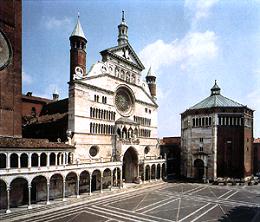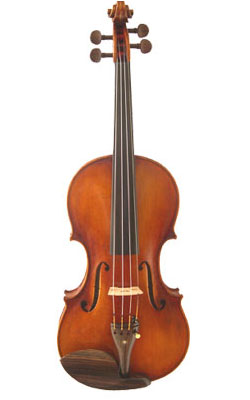 Cremona Duomo (Italy)
The violin-makers of Cremona came, as we have said, from Brescia, beginning with the Amatis. Though it does not lie within the province of this work to discuss in any special or technical sense the history of violin-making, something concerning the greatest of the Cremona masters will be found both interesting and valuable as preliminary to the sketches of the great players which make up the substance of the volume. The Amatis, who established the violin-making art at Cremona, successively improved, each member of the class stealing a march on his predecessor, until the peerless masters of the art, Antonius Stradiuarius and Joseph Guarnerius del Jesû, advanced far beyond the rivalry of their contemporaries and successors. The pupils of the Amatis, Stradiuarius, and Guarnerius settled in Milan, Florence, and other cities, which also became centres of violin-making, but never to an extent which lessened the pre-eminence of the great Cremona makers. There was one significant peculiarity of all the leading artists of this violin-making epoch: each one as a pupil never contented himself with making copies of his master's work, but strove incessantly to strike out something in his work which should be an outcome of his own genius, knowledge, and investigation. It was essentially a creative age.
Let us glance briefly at the artistic activity of the times when the violin-making craft leaped so swiftly and surely to perfection. If we turn to the days of Gaspard di Salo, Morelli, Magini, and the Amatis, we find that when they were sending forth their fiddles, Raphael, Leonardo da Vinci, Titian, and Tintoretto were busily painting their great canvases. While Antonius Stradiuarius and Joseph Guarnerius were occupied with the noble instruments which have immortalized their names, Canaletto was painting his Venetian squares and canals, Giorgio was superintending the manufacture of his inimitable maiolica, and the Venetians were blowing glass of marvelous beauty and form. In the musical world, Corelli was writing his gigues and sarabandes, Geminiani composing his first instruction book for the violin, and Tartini dreaming out his "Devil's Trill"; and while Guadognini (a pupil of Antonius Stradiuarius), with the stars of lesser magnitude, were exercising their calling, Viotti, the originator of the school of modern violin-playing, was beginning to write his concertos, and Boccherini laying the foundation of chamber music.
 Il Cannone, violin by Giuseppe Guarneri
There can be no doubt that the conditions were all highly favourable to the manufacture of great instruments. There were many composers of genius and numerous orchestras scattered over Italy, Germany, and France, and there must have been a demand for bow instruments of a high order. In the sixteenth century, Palestrina and Zarlino were writing grand church music, in which violins bore an important part. In the seventeenth, lived Stradella, Lotti, Buononcini, Lulli, and Corelli. In the eighteenth, when violin-making Avas at its zenith, there were such names among the Italians as Scarlatti, Geminiani, Vivaldi, Locatelli, Boccherini, Tartini, Piccini, Viotti, and Nardini; while in France it was the epoch of Lecler and Gravinies, composers of violin music of the highest class. Under the stimulus of such a general art culture the makers of the violin must have enjoyed large patronage, and the more eminent artists have received highly remunerative prices for their labours, and, correlative to this practical success, a powerful stimulus toward perfecting the design and workmanship of their instruments. These plain artisans lived quiet and simple lives, but they bent their whole souls to the work, and belonged to the class of minds of which Carlyle speaks: "In a word, they willed one thing to which all other things were made subordinate and subservient, and therefore they accomplished it. The wedge will rend rocks, but its edge must be sharp and single; if it be double, the wedge is bruised in pieces and will rend nothing."
Related resources:
The contents, views and opinions in this article are those of its author.
|